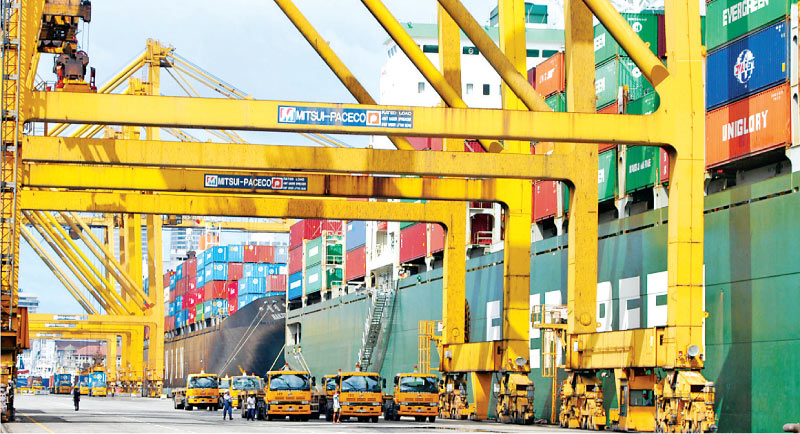Wednesday Jan 14, 2026
Wednesday Jan 14, 2026
Tuesday, 1 August 2023 03:52 - - {{hitsCtrl.values.hits}}

Sri Lanka’s external trade plunged sharply in the first half of 2023 reflecting challenging times.
As per the latest data from the Central Bank, cumulative export earnings during January to June 2023 registered a 10% decrease year-on-year (YoY) to $5.87 billion, whilst import expenditure during the same period saw a substantial decline of 18.6% YoY to $ 8.16 billion.
It also noted the deficit in the trade account from January to June 2023 narrowed to $ 2.89 billion, a considerable improvement from the $ 3.5 billion recorded during the same period in 2022.
As the country continues its journey towards economic recovery, maintaining this positive trend and addressing structural vulnerabilities will be crucial in ensuring long-term economic stability. Thus, the narrowing trade deficit showcases some progress in managing trade imbalances.
In June, earnings from exports declined by 19.5% YoY to just over $ 1 billion. The Central Bank noted that this decline mainly reflected the high base in June 2022, and all major subcategories of merchandise exports recorded a decline in June 2023 compared to year earlier.
However, in contrast, expenditure on imports increased by 11.6% $ 1.36 billion in June 2023, compared to $ 1.22 billion in June 2022. The Central Bank said the increase in import expenditure was observed across all main categories of imports, which was supported by the significantly low base in June 2022.
Detailing the imports, it said the biggest intermediate goods category of imports in June saw a rise of 7.3% YoY to $ 875.4 million, which also includes fuel bills rising by 45% YoY to $ 290 million and investment goods marginally increasing by 2.5% YoY to $ 239.9 million and consumer goods imports increased significantly by 42.6% YoY to $ 251.7 million.
The Central Bank said the relaxation of import restrictions, commenced during June and July 2023, could gradually generate higher import expenditure in the period ahead.
Expenditure on the importation of consumer goods increased in June 2023, compared to a year ago, driven by the increases in expenditure on both food and non-food consumer goods. Expenditure on food and beverages increased due to the increase in import volumes of sugar; oils and fats (primarily, coconut oil); and vegetables (primarily, lentils).
A sizeable increase in expenditure on non-food consumer goods was due to the imports of medical and pharmaceuticals (mainly, medicaments), telecommunication devices (mainly, mobile telephones), and cosmetics and toiletries.
Expenditure on the importation of intermediate goods also increased in June 2023, mainly driven by the imports of fuel and base metals (mainly, iron and non-alloy steel). Import volumes of crude oil and refined petroleum increased in June YoY, although coal imports remained limited due to the off-season.
Import expenditure on investment goods also increased in June 2023, compared to June 2022, recording the first year-on-year increase since February 2022. The increase in imports of machinery and equipment (primarily, machinery and equipment parts, turbines, and telecommunication devices) mainly contributed to this increase. In addition, expenditure on the importation of building materials increased marginally, while imports of transportation equipment recorded decline in June 2023.
The import volume index improved by 28.8% YoY, while the unit value index declined by 13.3% YoY, indicating that the increase in imports reflected the higher import volumes.
Describing June earnings from the exports the Central Bank said industrial goods declined in June 2023, compared to June 2022, due to a broad-based decline in earnings from most of the industrial products led mainly by garments. Exports of garments to most of the major markets (the USA, the EU and the UK) continued to record declines, resulting from subdued demand conditions in major markets.
Similarly, a sizable decline was recorded in the exports of rubber products (mainly, tires and gloves); petroleum products (due to lower average export prices); food, beverages and tobacco (mainly, vegetable, fruit and nuts preparations; and milling industry products); printing industry products; and animal fodder (mainly, poultry feed and copra residues). However, earnings from gems, diamonds and jewellery; and machinery and mechanical appliances increased in June 2023.
Earnings from the exports of agricultural goods also declined in June 2023, compared to a year ago, driven by lower export volumes of seafood (primarily, fresh and frozen fish), and coconut-related products (primarily, desiccated coconut, coconut oil and fibres). Earnings from tea exports declined led by lower volumes despite higher export prices. Further, the export subcategories of spices (mainly, pepper and cinnamon), vegetables, natural rubber, and unmanufactured tobacco recorded a decline in June 2023, compared to the previous year. However, earnings from minor agricultural product exports (mainly, areca nuts) improved to some extent.
The Central Bank also noted earnings from mineral exports declined in June 2023, compared to June 2022, mainly due to the decline in exports of earth and stone; and ores, slag, and ash.
The export volume declined by declined by YoY, while unit value indices also fell by 1.3% YoY, implying the decline in export earnings in June 2023 was mainly driven by lower export volumes.
Detailing the balance in the trade account in June the Central Bank noted it recorded a deficit of $ 364 million compared to the surplus of $ 22 million recorded in June 2022.